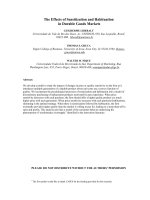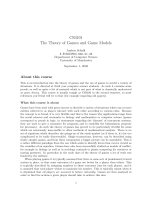The theory of implementation of socially optimal decisions in economics
Bạn đang xem bản rút gọn của tài liệu. Xem và tải ngay bản đầy đủ của tài liệu tại đây (8.66 MB, 180 trang )
The Theory of
Implementation of Socially
Optimal Decisions in
Economics
Luis C. Corchón
THE THEORY OF IMPLEMENTATION OF SOCIALLY
OPTIMAL DECISIONS IN ECONOMICS
This page intentionally left blank
The Theory of
Implementation of
Socially Optimal
Decisions in Economics
Luis C. Corch6n
Professor of Economics
Universidad de Alieante
Alicante
First published in Great Britain 1996 by
MACMILLAN PRESS LTD
Houndmills, Basingstoke, Hampshire RG21 6XS
and London
Companies and representatives
throughout the world
A catalogue record for this book is available
from the British Library.
ISBN 0-333-65794-2
First published in the United States of America 1996 by
ST. MARTIN'S PRESS, INC.,
Scholarly and Reference Division,
175 Fifth Avenue,
New York, N.Y. 10010
ISBN 0--312-15953-6
Library of Congress Cataloging-in-Publication Data
Corchon, Luis C.
The theory of implementation of socially optimal decisions in
economics / Luis C. Corch6n.
p. em.
Includes bibliographical references and index.
ISBN 0-312-15953-6
1. Decision making. 2. Welfare economics. I. Title.
HD30.23.C668 1996
330.15'56-dc20
96-7685
CIP
© Luis C. Corchon 1996
All rights reserved. No reproduction, copy or transmission of
this publication may be made without written permission.
No paragraph of this publication may be reproduced, copied or
transmitted save with written permission or in accordance with
the provisions of the Copyright, Designs and Patents Act 1988,
or under the terms of any licence permitting limited copying
issued by the Copyright Licensing Agency, 90 Tottenham Court
Road, London WI P 9HE.
Any person who does any unauthorised act in relation to this
publication may be liable to criminal prosecution and civil
claims for damages.
10
05
9
04
8
03
7
02
6
01
5
00
4
99
Printed in Great Britain "by
The Ipswich Book Company Ltd
Ipswich, Suffolk
3
98
2
97
1
96
To my wife, Maria del Mar
This page intentionally left blank
Contents
Introduction
xi
1 Economies with Public Goods
1.1
1.2
1.3
1.4
1.5
1.6
1.7
1.8
1.9
2
Introduction
Efficiency and public goods
The Core and public goods
Lindahl's equilibrium
Kaneko's ratio equilibrium
Mas-Colell and Silvestre's cost-share equilibrium
A criticism of the notions of equilibrium with an
auctioneer
Exercises
References
1
1
1
4
5
11
15
17
20
23
Resource Allocation Mechanisms
25
2.1
Introduction
An example of resource allocation: the case
of Adam and Eve
2.3 Description of the economic environment
2.4
Social objectives and incentives
2.5 Mechanisms
Strategic aspects
2.6
2.7 The problem of design
2.8 Summary
2.9 Exercises
2.10 References
25
Dominant Strategies and Direct Mechanisms
39
3.1
3.2
39
39
2.2
3
3.3
3.4
3.5
Introduction
The revelation principle
The impossibility of truthful implementation in
economic environments (I)
The impossibility of truthful implementation in
economic environments (II)
The manipulation of the initial endowments
Vll
26
28
29
30
31
33
35
36
37
44
47
56
Contents
viii
3.6
3.7
3.8
4
Conclusion
Exercises
References
Implementation in Nash Equilibrium (I):
General Results
4.1
4.2
Introduction
Characterization of social choice correspondences
implementable in Nash equilibrium
4.3· Implementation in Nash equilibrium in economic
environments
4.4. Implementation when the feasible set is unknown
and credible implementation
4.5
Exercises
4.6
References
Appendix: the King Solomon problem
5
Implementation in Nash Equilibrium (II):
Applications
5.1
5.2.
5.3
5.4
5.5
5.6
6
Introduction
Implementing the Lindahl and the Walras
correspondences by means of abstract mechanisms
Doubly implementing the ratio and the Walras
correspondences by means of market mechanisms
Implementation of solutions to the problem of fair
division
Exercises
References
58
59
62
65
65
66
73
78
80
83
85
89
89
90
96
104
108
110
Refining Nash Implementation
113
6.1
Introduction
6.2
Subgame perfect implementation
6.3
Implementation in undominated Nash equilibrium
6.4
Virtual implementation
6.5
Exercises
6.6
References
Appendix I: the control of externalities
Appendix II: double implementation in. Nash and strict
Nash equilibria
113
115
118
122
126
128
130
134
Contents
7 Bayesian Implementation
7.1
7.2
7.3
7.4
7.5
7.6
7.7
Introduction
Resource allocation under uncertainty
Games of incomplete information
Necessary and sufficient conditions for Bayesian
implementation
Ex-post efficient allocations and incomplete
information
Exercises
References
IX
137
137
137
140
141
149
153
155
Notes and References
156
Index
159
This page intentionally left blank
Introduction
A major purpose of social choice theory is to study the tradeoffs between different desiderata. This book focuses its attention on' a welldefined subset of social choice theory, namely the implementation of
socially optimal decisions in economics.
Implementation problems arise when the social planner (sometimes
a real person, sometimes a surrogate of society) cannot distinguish
between things that are indeed different. This may be due to the fact
that certain characteristics are unobservable to the planner or that even
if the planner has this information she cannot use it because of legal
requirements. For example, public monopolies are sometimes bound
by laws not to discriminate among consumers.
The quintessential implementation problem is that of the 'free rider',
that is, the agent who hopes to improve her luck by not telling the
truth about her own unobservable characteristic. (Imagine that you are
asked how much you would pay for the construction of a park near
your home and that in the case where the park is actually built this
amount is the one you would pay. Would you give a truthful answer?)
A closely related question was spotted by the ancient Romans and
summarized by the question 'who controls the controllers?' In the words
of Roger Myerson: 'An organization must give its members the correct incentives to share information and act appropriately. An individual cannot be relied upon to testify against himself or to exert efforts
for which he will not be rewarded' (in L. Hurwicz, D. Schmeidler and
H. Sonnenschein (eds) 1985, Social Goals and Social Organization,
(Cambridge University Press), chapter 8). But if these incentives must
be the right ones they bind the choice of the planner as much as the
scarcity of resources does: 'The basic insight of mechanism theory is
that incentive constraints should be considered coequally with resource
constraints in the formulation of the economic problem. In situations
where individuals' private information and actions are difficult to monitor,
the need to give people an incentive to share information and exert
efforts may impose constraints on the economic system just as much
as the limited availability of raw materials. The theory of mechanism
design is the fundamental mathematical methodology for analysing these
constraints' (Roger Myerson (1989), entry on 'Mechanism Design' in
the J. Eatwell, M. Milgate and P Newman (eds), New Palgrave (London:
xi
xii
Introduction
Macmillan). Chapter 1 of this book presents the 'classical' theory of
resource allocation in which incentive problems are entirely disregarded.
Chapter 2 presents the main ingredients of the approach that will be
followed in the rest of the book where incentives of agents are carefully modeled.
Some writers have argued that the kind of opportunistic behavior
implied by the 'free rider' problem accounts only for a part of the
story (see, for instance, D. North, Structure and Change in Economic
History, New York, Norton, 1981, chapter 5). Indeed one of the most
fundamental contributions of the Theory of Implementation has been
to show that the 'free rider' problem mayor may not occur, depending on the kind of game that agents play and on the (game-theoretical)
solution concept. In fact the story of implementation theory is that of
a liberation from constraints. The first major development was in the
work of Gibbard-Hurwicz-Satterthwaite in the early 1970s: when information is private, and thus the appropriate equilibrium concept is
dominant strategies, incentives bite a lot. These incentives adopt the
form of incentive compatibility constraints where for each agent to
tell the truth about her characteristic, must be a dominant strategy.
This and related topics are discussed in Chapter 3. The second major
development case from Maskin in the late 1970s: when the information about the characteristics of the agents is shared by them (but not
by the planner), and thus the relevant equilibrium concept is Nash equilibrium, incentive compatibility does not matter. Thus, for instance, by
putting agents in a circle, if each agent is able. to monitor the characteristics of her neighbors the free rider problem dissolves. What it bites
here is a, generally much weaker, monotonicity condition that can be
explained as follows. Suppose that an allocation, say a, is optimal for
some preferences. Now preferences change in such a way that a goes
up in all individual rankings about allocations. Then a must also be
socially optimal for the new preferences. Chapter 4 is devoted to explaining the theory of Nash implementation. The third big push came
in the mid-1980s from Moore and Repullo.' They and their followers
exploited the knowledge gathered on Nash equilibrium refinements in
thelate 1970s and early 1980s that followed the lead of Reinhard Selten.
By discarding some Nash equilibria (because they are not subgame
perfect or they are weakly dominated, etc), they were able to show
that neither incentive compatibility, nor monotonicity bite (see
Chapter 6 below). Thus, in this approach, incentives do not have any
cutting power.
We should mention here two more highlights of implementation theory.
Introduction
xiii
One is the theory of implementation in Bayesian equilibrium (a concept developed by John Harsanyi) where agents act under incomplete
information. Constraints implied by Bayesian implementation are both
a form of incentive compatibility and a certain monotonicity restriction. Another important topic is the construction of 'nice' mechanisms
(including those inspired in the market) implementing specific social
goals. These issues are discussed in chapters 7 and 5 respectively of
this book. My guess about the direction of future research is that it
will move towards the consideration of dynamic models and a less
mechanical formalization of the rules of the game (on this matter the
paper by Hurwicz in the first issue of Economic Design is warmly
recommended).
This book concentrates on the study of two questions. First of all, we
win study which kind of social decisions can be implemented by noncooperative games by means of various types of equilibrium (dominant strategies, Nash or some of its refinements, Bayesian equilibria,
etc.). Secondly, we will study some concrete mechanisms which implement 'good' social decision rules. The emphasis of the applications
will lie on the implementation of the Lindahl correspondence in economies
with public goods. Pure exchange economies are also considered. Each
chapter includes a collection of problems. These problems are meant
to supplement the exposition of the main text and to test the understanding of the reader about certain questions. They also provide additional references of important work.
This book is based on my lecture notes for a course in the PhD
program of the University of Alicante. It is a pleasure to acknowledge
the challenging intellectual atmosphere of my department led by people
like Carmen Herrero, Fernando Vega-Redondo, Ignacio Ortufio-Ortin,
Paco Marhuenda, Subir Chattopadhyay and Antonio Villar. Thanks to
a Fulbright scholarship I could visit the Department of Economics of
the University of Rochester. There I learnt Implementation Theory from
William Thomson. My debt to William is immense not only because
of his guidance and care but also because my contact with his students
proved to be very fruitful for my future research. Among them, Simon
Wilkie, Baskhar Chakravorty and Tomas Sjostrom became co-authors.
Parts of our joint research have been used freely in this book. The
group also included J.P. Conley, D. Diamantaras, T. Shinotsuka and T.
Yamato among others. I also owe to Ignacio Ortufio-Ortfn countless
illuminating discussions on the role of Implementation Theory. A part
of them came out as a joint paper reviewed in Chapter 7. Another
xiv
Introduction
joint paper with my former student Carmen Bevia forms the basis for
a section in Chapter 3. John P. Conley corrected some serious misunderstandings of mine in Chapters 1 and 2. Chapter 3 benefited from
the insightful comments of Salvador Barbera. I am also indebted to
my fellows Jose Alcalde, Inigo Iturbe-Ormaetxe, 'Diego Moreno, Javier
Lopez-Cufiat and to several generations of students of the PhD program of the University of Alicante, especially to Pablo Amoros, Bernardo
Moreno and Socorro Puy for correcting my mistakes. J. Alcalde and
B. Moreno are co-authors of a paper that became the backbone of
Appendix I to Chapter 6 and S. Baliga is co-author of a paper reviewed in Chapter 5. I am specially indebted to Jorg Naeve for his
careful reading. He amended several inadequacies in propositions 1
(Chapter 3), 2 (Chapter 4) and 2 and 3 in Chapter 7. The proof of
these. results presented in this book are virtually his. My secretary,
Mercedes Mateo, did many of the drawings and with her efficiency
contributed to my dedication to the book. The latter also apply to Vera
Emmen. It is only fair that I thank warmly all these persons for the
various kind of help that they have given me. This book could not
have been written without them, but I alone am responsible for any
error.
LUIS C. CORCHON
1 Economies with Public
Goods
1.1
INTRODUCTION
A public good is one for which there is non-rivalry in consumption,
that is, if the good is consumed by individual i, this does not preclude
individual j from consuming it. When there is neither exclusion nor
free disposal a public good becomes a collective decision whose consequences affect the whole of society. Pure public goods are those whose
quantity consumed by each member of the society is identical. It should
be noted that a public good is a special sort of externality.
Examples of public goods include: (i) goods which are generally
offered by central governments, such as the armed forces, the police
force and, to some extent, roads, railways, social security and justice;
(ii) Goods of a more local nature offered by autonomous governments
or town councils, such as lighting, sewer systems, the collection of
refuse, bridges and parks; (iii) goods offered by the public or private
sector such 'as TV, radio, inventions and pollution. Therefore, it must
be noted that (a) a public good is not necessarily desirable (even though
under free disposal its consumption might be avoided) and (b) it is not
necessarily offered by the public sector.
In this chapter the following problem will be studied: Suppose we
have a society where there are both private and public goods. Does an
optimal way of organizing this society exist? In order to examine this
question, we will first of all formally describe an economy with public
and private goods.
1.2
EFFICIENCY AND PUBLIC GOODS
We will suppose that there are n consumers, l pure private goods and
m pure public goods. Each consumer has a vector of initial resources
of private goods Wi. A consumption bundle for each individual i is an
l + m dimensional vector (Xi' y) E Xi ~ lRl+ m , where the first (resp.
the second) component of the vector denotes the consumption of private
2
Implementation of Socially Optimal Decisions
(resp. public) goods and Xi represents the consumption set of the ;th
agent. Note that the consumption of public goods is not denoted by a
subscript as it is the same for all agents. Each consumer has preferences regarding the consumption bundles, which can be represented
by a utility function u i : Xi ~ fR. The technology of the economy will
be described by a set Yc fRl +m or sometimes by the function Ttz ; y) =
o where z is an I-dimensional vector which represents the input (positive) output (negative) vector of private goods and y is the vector of
outputs of public goods. 1 If Y = {O} we have an exchange economy.
If (z , y) E Y ~ y = 0 we have an economy where only private goods
are produced.
An allocation denoted by (x, y) is a list of bundles for each individual. An allocation is individually feasible if for each agent i, (Xi' y)
E Xi. An allocation is feasible if it is individually feasible and 3 z
n
n
with (z, y) E Y and i'Jd:JXi + Z :5 t:J Wi (social feasibility).
Definition 1: An allocation (x, y) is Pareto efficient if it is feasible
and no other feasible allocation (x, y/ ) exists, such that u/x(, y/) 2
uJXi' y) for all i, and with strict inequality for at least one consumer.
It is possible to prove that if the utility functions are continuous, non. satiated and concave and the set of production possibilities is closed
and convex an allocation is Pareto efficient if and only if it maximizes
(XiUi(X p y) on the set of feasible allocations, for some vector
(al' ... ,an) that belongs to the simplex of dimension n - 1. That is
i
n
Max.
L aiui(xil'
;=1
s.t. T(ZI' ... ,Z1' Y1' ... , Ym)
=
. . . , Xii'
Y1' ... , Ym)
n
0 and L(w ij
-
xu)
= Zj j =
1, ... ,1
;=1
Let - ~ (resp. ~, j = 1, ... , 1) be the Lagrange multiplier associated
with the technological restriction T(z, y) = 0 (resp. social feasibility
(w;j - Xi) = z). As it was first noticed by
for private goods
!I
Samuelson, if the utility functions and the function T( ) are continuously
differentiable, the necessary conditions for an interior maximum are:
k
=
1, ... ,m
Economies with Public Goods
au;
a.rzr:
, ax.. - Yj
=0
i
=
I, ... , n ; j
=
3
1, ... , 1
I)
j
1, ... , 1
Therefore,
n
du.
;=1
:h,1
v r«
~ a.
I
+
au aT
as
::'I s
;h,
dXsj
uYr
er
1::'1
0
dZ j
So, we obtain
n
dyk
au;
st
~-=
;=1
aT
au;
dyk
'V k
=
1, ... , m; 'dj
=
1, ... , I.
aXij
which shows us that in a Pareto efficient allocation the sum of the
marginal relations of substitution between any public or private good
must be equal to the marginal rate of transformation between these
goods (the latter is easily obtained differentiating T( ) ). This condition is called Lindahl-Bowen-Samuelson and is analogous to the equalization of marginal rates of substitution and transformation, which must
occur in an efficient allocation if there only exist private goods.
It is useful to have a graphical illustration of the set of feasible
allocations in an economy of public goods, equivalent to Edgeworth's
box in economies with only private goods. This construction is called
Kolm's triangle (after its inventor, Serge-Christophe Kolm) and it assumes n = 2, 1 = m = 1 and constant returns to scale. A detailed
explanation can be found in the book of J.J. Laffont quoted in the
references in section 1.8 below. Figure 1.1 shows Kolm's triangle where
the set of efficient allocations is indicated.
Implementation of Socially Optimal Decisions
4
Initial endowments
Figure 1.1 Kolm's triangle
1.3
THE CORE AND PUBLIC GOODS
The notion of core is the application of the idea of Pareto efficiency to
a situation where any coalition (i.e. a non-empty subset of the set of
agents) can be formed. We assume that each coalition has free access
to the technology, in other words, that the production set only includes
technical details that are common knowledge in the society. Consequently,
all the specialized technical knowledge is included in the commodity
space. The concept of core we will use is termed as Foley's core.
Definition 2: A feasible allocation (x , y) is in Foley's core if there
is no coalition C and an allocation for the members of C, (x;, y' )iEC
such that u/x(, y') ~ u ix; y) for all i E C and with strict inequality for at least one j E C with (z', y') E Y and L(W j - x/) ~ z',
iEC
some z'.
Economies with Public Goods
5
In other words, an allocation is in Foley's core if there is no coalition
which, producing the public good with its own resources, is able to
increase the utility of some of its members without diminishing that of
any member. This notion tries to capture the idea of some type of
social stability in the sense that any allocation which is not in the core
cannot be stable if there exists a possibility for binding agreements
between members of the society.
Notice that the coalitions that 'deviate' cannot hope for anything
from the complementary coalition. This can be interpreted as saying
that the deviating coalition separates itself from the society and will
have to provide its own public goods. In this case separation from the
society implies an exclusion from consumption of the public good.
However, members of the society cannot be excluded from this consumption (think about the case of the police or the armed forces). In
this sense, society behaves like a private club, excluding non-members.
In other words, we must distinguish between non-rivalry in consumption (which is the essential characteristic of a public good) and nonexclusion. Other notions of the core can be constructed to cope with
situations where different concepts of blocking are available.
It can be easily observed that if an allocation is in Foley's core it is
Pareto efficient but not necessarily vice versa. Finally notice that, in
the case of exchange economies, individuals can obtain in any core
allocation at least the utility corresponding to the consumption of their
initial endowments (any other allocation is improved upon by a oneperson coalition). This property is called individual rationality. However, in our case, individuals can guarantee in any core allocation an
even greater utility since they have access to the production set. We
will call this property strong individual rationality. In formal terms, an
allocation (x", y") is individually rational if V i = 1, ... , n, u;(x;': y")
~ uj(w i' 0). This corresponds to the area inside WCAEA' in Figure
1.2. An allocation (x', y') is strongly individually rational if V i =
1, ... , n, ui(x;', y') ~ Vi' where Vi = max u;(x;, y) s.t, {(Xi' y)/ Xi + Z
:5 Wi and (z, y) E fl. This corresponds to the area inside DBD' B' in
Figure 1.2. In this figure the core of the economy has been marked
with a thick line BB'. The curve AA' designates the individually rational
and Pareto efficient allocations.
1.4
LINDAHL'S EQUILIBRIUM
In this and the following sections we will consider a family of notions
of equilibrium based on the following characteristics: (i) the decision
6
Implementation of Socially Optimal Decisions
E
r-----c---~'r-------
,.....r.--+---T--T-~----
Core
Individually
rational
set
w
Initial endowments
t
,Figure '1.2 The core in a public goods economy
regarding the quantity of public goods is unanimous and efficient; (ii)
This decision is decentralized by some parameterized schedules that
consumers take as given; (iii) There is an auctioneer, who announces
the parameters of the schedules.
This family of concepts of equilibrium includes: (a) Lindahl's equilibrium; (b) ratio equilibrium (Kaneko); (c) the cost-share equilibrium (Mas-Colell and Silvestre); and (d) Valuation equilibrium
(Mas-Colell), The fundamental difference between these concepts lies
in the type of parameters or functions announced by the auctioneer.
We win now concentrate on the first concept in which the auctioneer
announces (linear) prices.
Lindahl's equilibrium is an extension of the Walrasian idea of equilibrium to economies with public goods. An intuition of how it works
can be obtained from a simple economy (n = 2, m = l = 1) illustrated
in Figure 1.3. Suppose that (x;, y') i = 1, 2 is an efficient allocation.
Economies with Public Goods
7
y'
y'
z'
Figure 1.3 Lindahl equilibrium
y
z
8
Implementation of Socially Optimal Decisions
For both consumers we draw the supporting hyperplane for the set of
preferred points at (x;, y/) that if the utility function is differentiable,
it will coincide with the marginal rate of substitution evaluated at
(x;, y '). Note that the implicit prices in the two consumers' budget
restrictions are different, in other words, prices are personalized. We
also draw the production possibility set and the supporting hyperplane
at (z /, Y '). These prices, multiplied by the quantity of the public good,
can be interpreted as the taxes paid by each one of the consumers in
order to finance the production of the public good. Finally, the firm
receives an income equal to consumers' contributions. Therefore,
Lindahl's equilibrium is based on the creation of personalized markets
for public goods, where only one purchaser exists. This corresponds to
a much more general idea of the first best allocation of resources in a
world with externalities being obtained by creating a market for each
externality and assuming a price-taking behavior on the part of the
agents. The problem that arises here, as we will see at the end of this
chapter, is that in markets created in this manner, the price-taking behavior is far from rational.
We denote by d, the share of the consumer i in the profits generated
d, = 1.
by the use of technology, d, ~ 0 and
:t
1=1
Definition 3: A feasible allocation (x': yL) and an input vector ZL
are a Lindahl Equilibrium if there exists a price vector {(qf);=J ..
pL) with
E fRm and pLE lR~ such that
(a) Vi = 1, ... , n (xf, yL) maximizes ulxi , y) over
q7
qfy
+ pLX;
:5
pLW ;
nr
+ d, (IqyyL - pLZ)
j=l
(b) (yL, ZL) maximizes
I
n
qfy - pLZ over (z, y) E Y
;=1
Note that we have not assumed that the vector of personalized prices
for public goods is non-negative. This is due to the fact that if some
consumer does not like a public good, she will have to be subsidized
('bought off') so that the decision concerning the quantity of the public good to be produced is unanimous.
A public goods economy can be reduced to an economy where there
are only private goods in the following way. We consider that each public
good consumed by each consumer is a private good consumed only by
her. Therefore, for each public good we have n 'private' goods jointly
produced in fixed proportions. We now define a Walrasian equilibrium in
this new economy in the usual way. Then, the allocation and the price
Economies with Public Goods
9
vector of Walrasian equilibrium are a Lindahl equilibrium. This suggests
that the proof for the existence of the Walrasian equilibrium can be extended to prove the existence of the Lindahl's equilibrium. However, in
this case, the continuity of the budget constraint is not assured unless we
suppose that the individuals possess strictly positive initial resources of
public goods. 1, ... M. The existence of a Lindahl equilibrium will be
obtained as a corollary of Proposition 4 in the next section.
We will now study the relationship that exists between the core and
the Lindahl equilibrium.
Proposition 1: If there are constant returns to scale, the utility of
every consumer is strictly increasing for some good and never decreasing for public goods, the Lindahl equilibrium allocation is in
Foley's core.
Proof: We suppose that this is not so. Therefore :IC, (x!, y' )iEC' such
that uJx~, y') ~ uJxf, yL) 'tf iEC with strict inequality for some jEC
and such that Y: (Wi - x/) ? z' and T(z', y') = o. Therefore if
IEC
(x], y') was not chosen at the prices of Lindahl's equilibrium it must
be true that pLX / + qfy' ~ pLxf + qfyL = t/w, 'ijEC (where the
fact that the utility is increasing for some good has been made use
of) with strict inequality for some JEC. Summing on C we obtain
Iqfy' > pL
I
iEC
ieC
(Wi -
x;') ~ pLZ '
As the consumers' utility is not decreasing for public ~oods, all qf
prices are non-negative and consequently E, qf:$ I q~ As the
IEC
n=l
firm maximizes its profits and there are constant returns to scale,
o=
17 qfyL ;=1
pLzL ~
z
q fy' - pLZ ' > O. Contradiction.
iEC
It is clear that the inverse relation does not necessarily hold in finite
economies (see Figure 1.4). Even in infinite economies the core can
be larger than the competitive equilibrium, in contrast with economies
of private goods where they coincide. Intuitively, the reason for this is
that on replicating an economy with public goods, it is as if we were
replicating the quantity of private goods in the artificial joint production
economy mentioned before. Therefore, the standard approach (where
the number of goods is given) cannot be applied.
10
Implementation of Socially Optimal Decisions
I~----- Lindahl prices
Foley's
core
------.,f------,
. . - \ - - - - - - - Lindahl equilibrium
allocation
\
Initial endowments
Figure 1.4
Lindahl equilibrium in the Kolm triangle
Finally, we will prove that Lindahl's equilibrium generates allocations that are Pareto efficient.
Proposition 2: If the utility of any consumer is strictly increasing
for some good, the allocation of Lindahl 'sequilibrium is Pareto efficient.
Proof: It is identical to that of Proposition 1.
Note that in this case it is not necessary either that the consumers'
utility be non-decreasing for public goods or that there be constant
returns to scale. If both assumptions were postulated, Proposition 2
would be a Corollary of Proposition 1 and the fact that any allocation
in the core is Pareto efficient.









